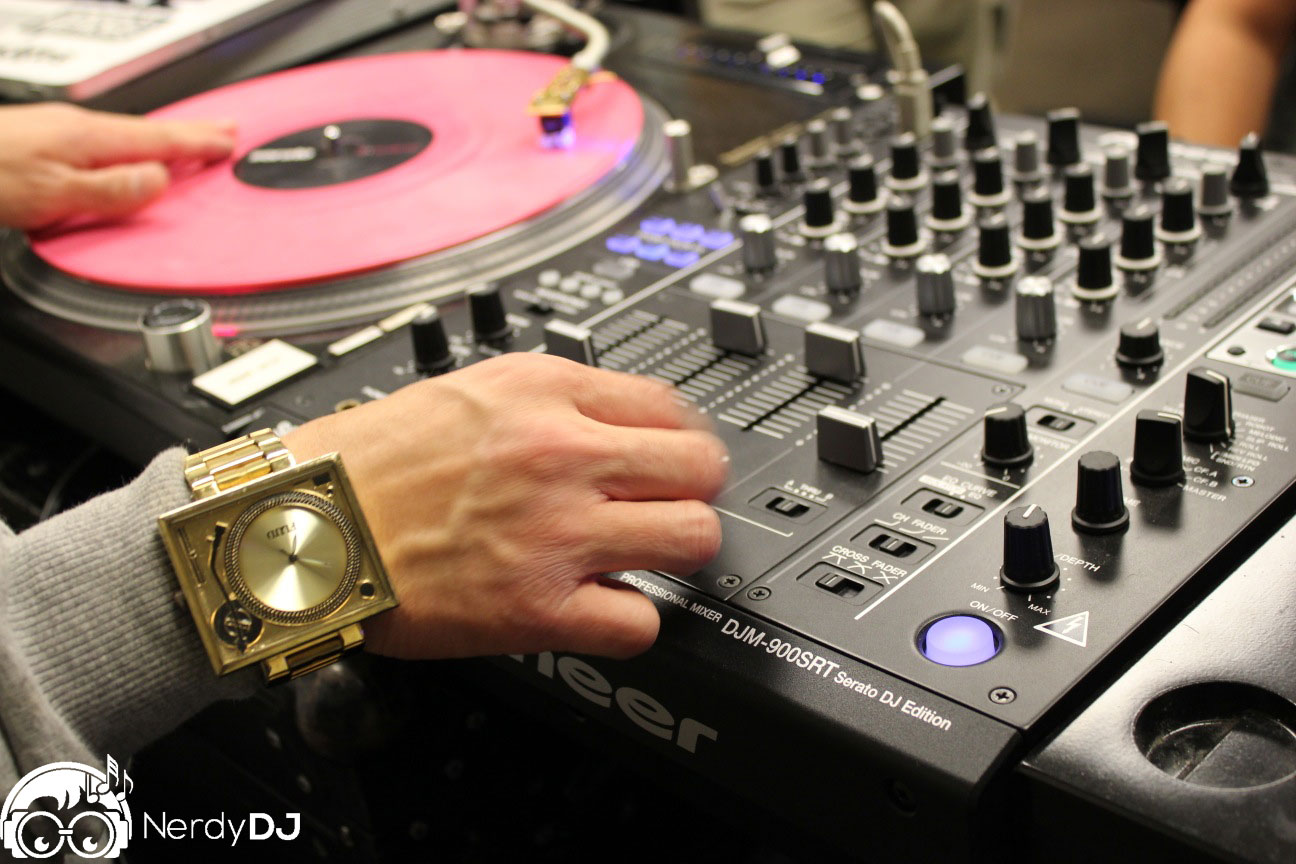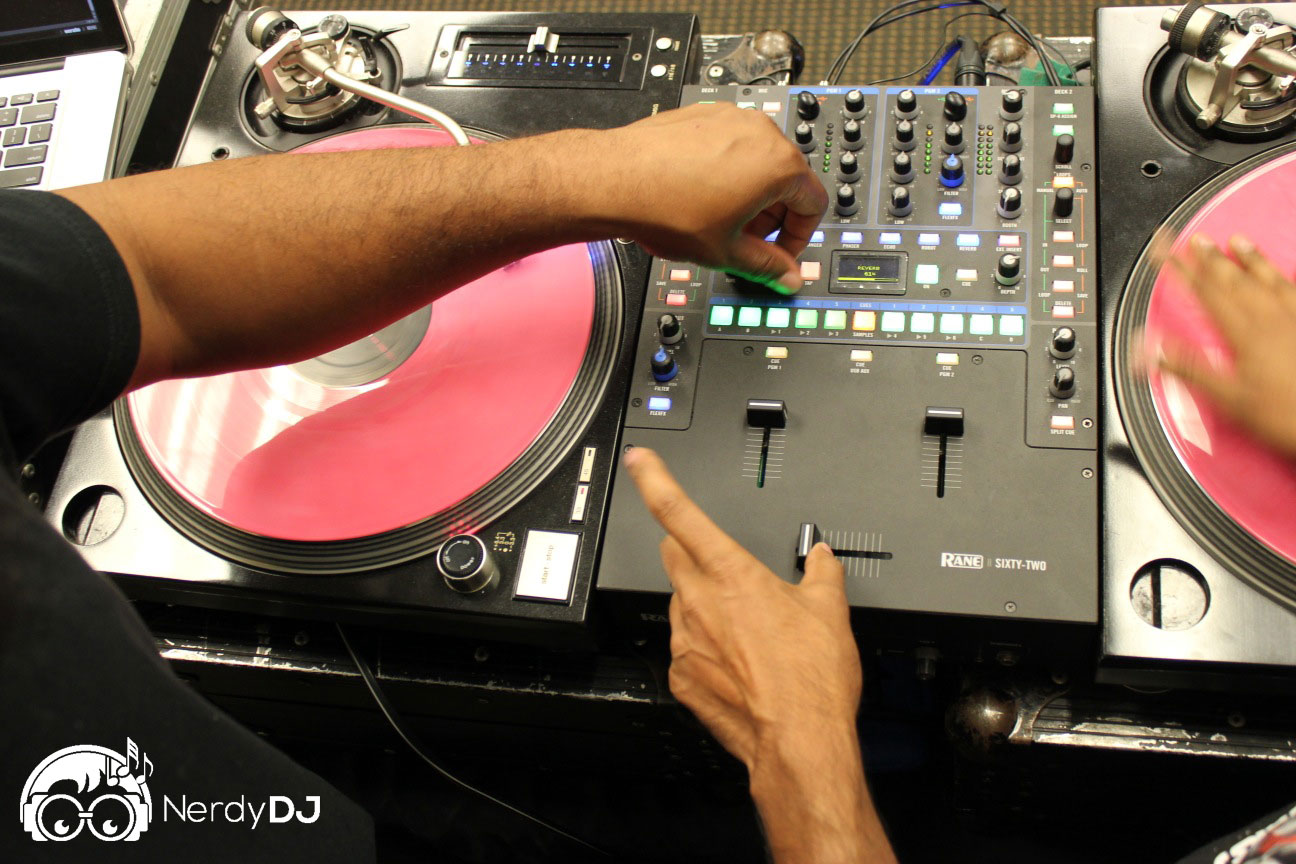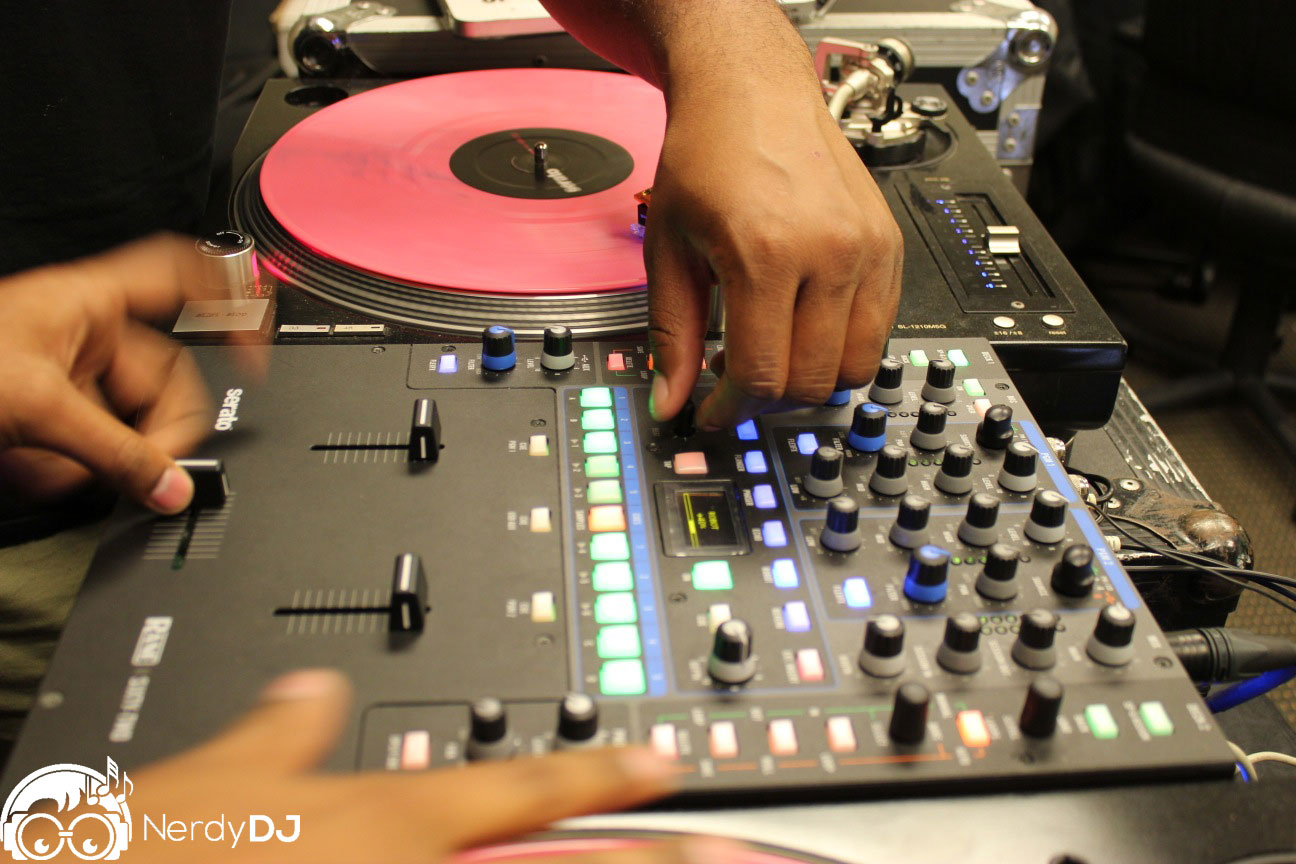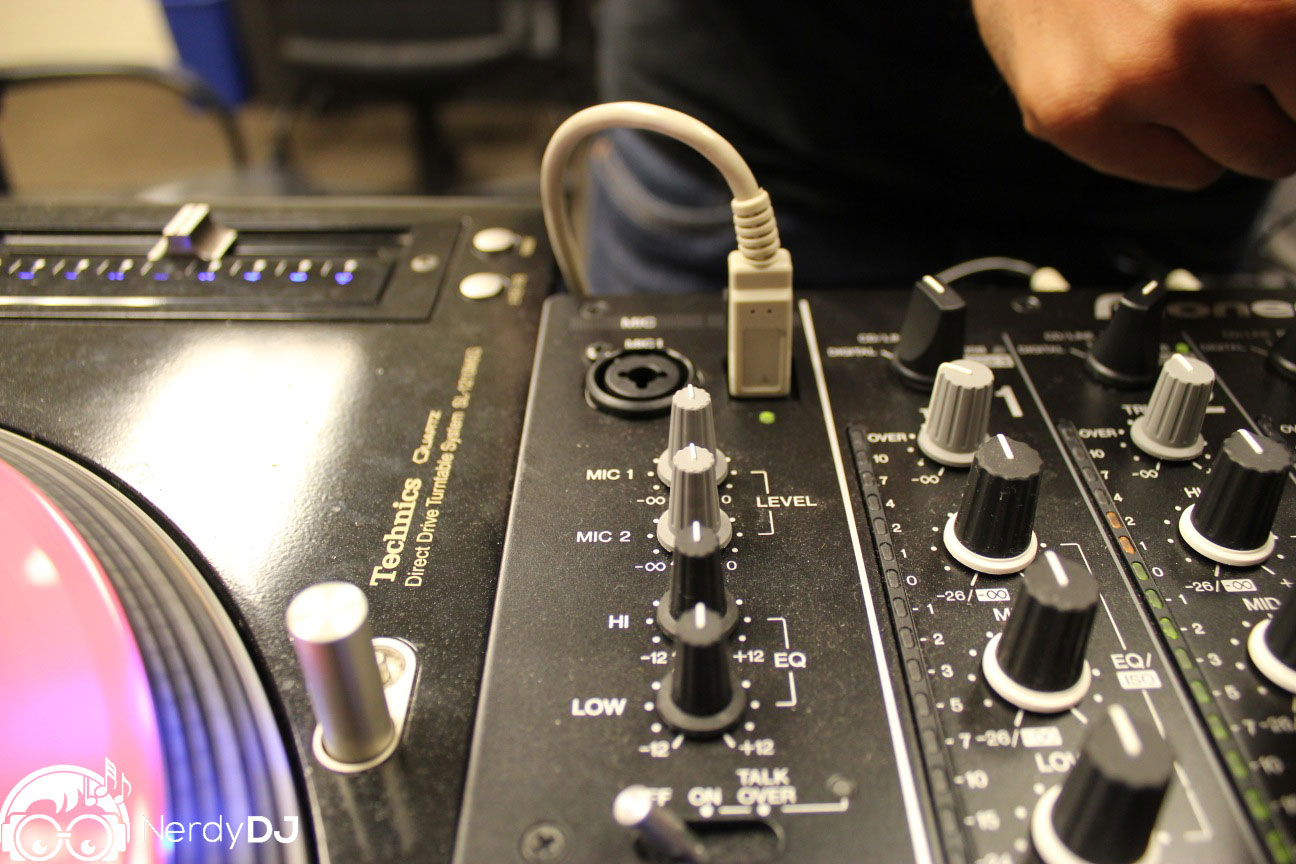
Why put the Rane Sixty-Two against the Pioneer DJM-900SRT?
Before we start, we’re aware a more fair comparison may be between the Rane Sixty-Eight and  the Pioneer 900. That’s something we understand, and we know comparing a four channel mixer to a two channel mixer is somewhat off base, but we’re comparing the two mixers people are most likely to buy, and two that are available now. For that reason we won’t mention differences in size because that’s something that will obviously different.
So, here you are with a decision to make: which mixer is better? Which company should get your hard-earned money? Read on to find out:
Update: Just to clarify a very important point: in an effort to provide an unbiased review, both of these mixers were evaluated straight out of the box. We are aware things can be corrected with modification, but this review is for both mixers straight from the factory!
Rane Sixty-Two vs. Pioneer DJM-900SRT: Nobody’s Perfect
To be honest, none of us in the group were totally sold on either of these mixers as a “best solution” and we felt both had some pros and cons of their own. So we’re going to narrow it down to what most DJs care about the most, and then break down the pros and cons of each model specifically.
Which Mixer Has A Better Crossfader?
A valid question! Arguably the most used function of a mixer, especially if you’re a hip-hop DJ, the crossfader is a make it or break it aspect for most of us. Which one has the best crossfader? Well, it’s hard to say really. I know that sounds surprising, most of us would expect the Rane to be the clear winner in this arena, but it’s a closer race than we thought it would be. We think physically and ergonomically speaking the Rane Sixty-Two has the better crossfader build. The fader cap on the Sixty-Two just feels better when scratching, and it’s also built a little more heavy/strong. There were times when we felt like the DJM-900SRT felt light and cheap. It should also be noted that because of the headphone placement on the DJM-900SRT we sometimes found our hands hitting the headphone adaptor while scratching.
Unfortunately that’s not all it takes to decide a winner. We also have to consider another major factor: when the crossfader physically starts to activate across the rails. Meaning: how far does the fader have to move before sound changes and how quickly can it cut back out when the fader is moved back to the edge? The champion in our test in this aspect is the DJM-900SRT. The sound activates and cuts more quickly and we found our scratches sound a bit better because of this. Obviously with enough practice this is a non-issue, but you want to pick up the mixer and get busy right away, right? It should be noted we tested the Sixty-Two with Scratch Live and the DJM-900SRT with Serato DJ – could this have something to do with it? Maybe. We toyed with latency settings to make sure was it an accurate test though).
This may come as a surprise but as far as the Rane Sixty-Two is concerned, we felt ourselves longing for the crossfader actions of the TTM-57SL, which is arguably Rane’s best mixer. We felt like the crossfader was a bit of a step back from that model.

Winner: Pioneer DJM-900SRT.
Which Mixer Works Better With Serato DJ?
Listen, Rane has been building products to work with Serato for years. They built the blueprint for a Serato mixer, so it’s no surprise that the Sixty-Two is better at the task. Control cue points and samples with buttons that are smartly placed right above the fader area. Start, stop, and roll loops with buttons and knobs on either side of the mixer. Everything is laid out with a great sense of ergonomics, making it easy to use both the looping section of the mixer, and the cue point section, easily at the same time. This mixer covers all the essential functions that you’d want it to and does it well.
The DJM-900SRT was not designed with Serato in mind. Sure, it’s Serato capable, but what does that really mean? To us it really just seems like they took the existing 900, slapped on the components necessary to make it work with Serato, and called it a day. It’s Pioneer’s first entry into this market, and unfortunately for them, it’s a misstep. Serato is more of an after thought and not a full integration. Quite a shame considering all the progress they’ve made with their controllers lately. This is also obviously not a factor if you’re using CDJ-2000s in HID mode, but we’re not comparing full set ups here, we’re comparing mixers.

Winner: Rane Sixty-Two.
Which Mixer Has Better Build Quality?
We all agree this is one area where the Rane Sixty-Two falls a bit short. The overall look and feel of the mixer does not match up to the price tag. Although the buttons are placed well, they don’t feel well. They also don’t feel like they are going to stand the test of time and heavy use that most of us will subject it to. In fact we’ve already seen more than one Sixty-Two with the cue buttons broken/pushed in. We also feel like the buttons should be a bit more rubberized to give a better tactile feel. I’ve already mentioned this to Rane and they assure me any issues will be resolved (we’ll be talking about their outstanding customer service later):
@RaneDJ full disclosure, will mention build quality as one of our issues with the 62 (have seen several with broken/pushed in buttons).
— The Nerdy DJ (@thenerdydj) December 2, 2013
@thenerdydj We'll start w/ the best warranty in the biz! We stand behind our work. Any issues, call us. A few busted caps, not wide spread.
— RANE (@RaneDJ) December 2, 2013
The DJM-900SRT is built with the same quality you’ve come to expect from Pioneer mixers. There is a reason Pioneer mixers are the de facto standard in clubs around the world and are featured on most tech riders of the big guys: they’re reliable, they’re tough, and they’re . Everything on this thing feels like it will last. Every button, every knob, every fader cap (although the ones on our unit didn’t always sit perfect horizontal and had a bit of play to them:

Winner: Pioneer DJM-900SRT
On The Topic of FX (And Sound Quality)
Pioneer has hand a longstanding stronghold in the FX arena. From onboard FX to add-on units, if there’s one thing Pioneer does well, it’s FX. With that said, Rane has put themselves in contention with the Sixty-Two offering up a solid set of FX that rival Pioneer. In our opinion the Rane really excels because of ergonomics and ease of use. After all, what good are the FX if you can’t get to them and trigger them easily? We’ll have to serve this up as a tie in our test because we weren’t able to test on a real sound system – which is why we also can’t judge difference in sound quality.

Winner: Tie
USB Ports: Two is Better Than One
We felt like this deserved it’s own section because this is something that is definitely going to make people decide one way or another on these two models. DJs that often spin with other DJs will find the Rane Sixty-Two’s dual USB ports invaluable. Being able to simultaneously run two laptops and switch back and forth between the two is a welcome blessing. Gone are the days of chaining together a TTM57 and an SL box. Gone are the days of switchover records. Gone are the days of talking on the mic while you tap dance around the booth to switch laptops. Gone. Two USBs changes the game. This should be a standard feature on any Serato enabled mixer going forward. Which brings us to the DJM-900SRT.
The DJM-900SRT has just one USB port. WHY? This is a huge missed opportunity for Pioneer. If you want the same seamless two laptop setup that comes standard on the Sixty-Two, you’ll need to have an additional SL box. Not only does the DJM-900SRT only have a single USB port, but the placement of the port annoyed us. They opted to place it on top of the mixer which puts it in harm’s way (this can be solved with a right angle adapter or cable like this one):

Winner: Rane Sixty-Two
The Battle of Personal Preferences
So we’re about neck and neck now on which mixer may be worth your money. We have a couple of notes for each model that we decided were just personal preference issues that may help you lean one way or the other
Rane Sixty-Two Mixer
- Split headphone cue requires pressing both cue buttons to hear both channels in headphones. Some prefer each press to be an on/off for each channel and not selecting just one channel.
Pioneer DJM-900SRT Mixer
- Ground connector is cheap and might break down the road. Probably because Pioneer prefers CDJS — wonder why that is?
- Up faders/channel faders don’t act the same way the crossfader does and feel like different faders in general. DJs that like to scratch via the up faders will find it difficult.
The Verdict: Which One Should You Buy?
There’s honestly no clear winner. It all comes down to what you already have experience with and favor. We believe open format and hip-hop DJs will favor the Rane Sixty-Two. For those of you spinning mainly electronic formats where extended mixing is a factor, you’ll probably want the Pioneer DJM-900SRT. If you want two USB ports and/or the ability to control Serato DJ directly on the mixer, go with Rane. If you’re rocking CDJ-2000s, go with the Pioneer to complete the setup. If — and I find this very important – you like your issues resolved right away and your mixer serviced with quick turnaround, then go with Rane. They have the best customer service in the game!
The Rane Sixty-Two is currently priced at $1,999.00 at AGI Pro DJ
The Pioneer DJM-900SRT is currently priced at $2,299 at AGI Pro DJ
You can get a discount on either one by signing up for our newsletter at the bottom of this page and getting our exclusive AGI Pro DJ discount code.
Who Gave Input For This Review?
Special thanks to everyone that contributed and gave feedback for this review. We set up both mixers and the five of us talked about what we liked and didn’t like about each one. We all came to the same conclusion though which is that it’s a tough choice to make and there’s no ultimate winner.
Who decided that? This is all raw feed back from the following DJs: A-Minor, Paradime, Rang, Forge, and Kevin from No Regret Productions. Special thanks to No Regret Productions for letting us use the mixers and letting us set up in their office. If you are looking for DJ equipment rental in Raleigh, Durham, Chapel Hill area in NC, hit up No Regret Productions for all your DJ and Speaker rentals
We all play an average of three to four gigs per week in different locations, so we feel like we can speak for the working DJ. Of course, we’re not perfect, so if you feel like we missed something, or have more questions, hit us up in the comments below, or on twitter. Thanks for reading, and if you find it useful please share!